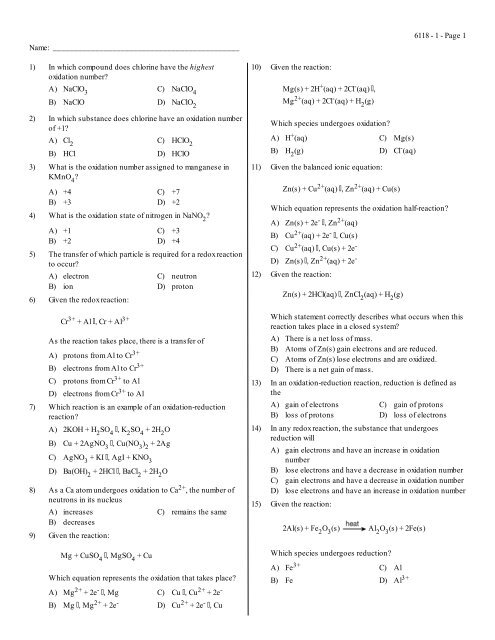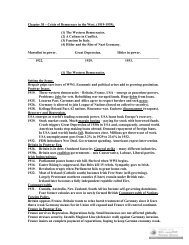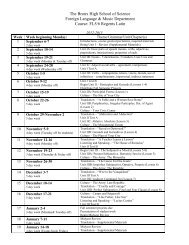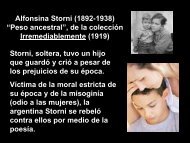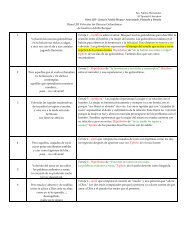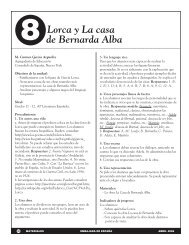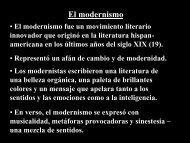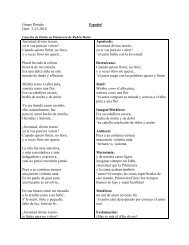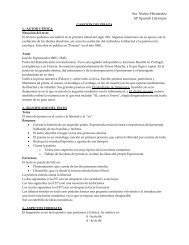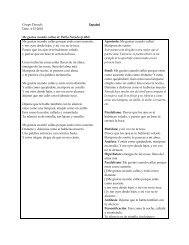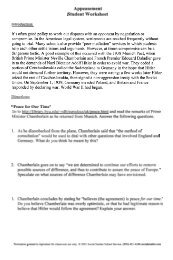1) In which compound does chlorine have the highest oxidation ...
1) In which compound does chlorine have the highest oxidation ...
1) In which compound does chlorine have the highest oxidation ...
Create successful ePaper yourself
Turn your PDF publications into a flip-book with our unique Google optimized e-Paper software.
Name: ____________________________________________<br />
1) <strong>In</strong> <strong>which</strong> <strong>compound</strong> <strong>does</strong> <strong>chlorine</strong> <strong>have</strong> <strong>the</strong> <strong>highest</strong><br />
<strong>oxidation</strong> number?<br />
A) NaClO 3<br />
C) NaClO 4<br />
B) NaClO<br />
D) NaClO 2<br />
2) <strong>In</strong> <strong>which</strong> substance <strong>does</strong> <strong>chlorine</strong> <strong>have</strong> an <strong>oxidation</strong> number<br />
of +1?<br />
A) Cl 2<br />
B) HCl<br />
C) HClO 2<br />
D) HClO<br />
3) What is <strong>the</strong> <strong>oxidation</strong> number assigned to manganese in<br />
KMnO 4<br />
?<br />
A) +4<br />
B) +3<br />
C) +7<br />
D) +2<br />
4) What is <strong>the</strong> <strong>oxidation</strong> state of nitrogen in NaNO 2<br />
?<br />
A) +1<br />
B) +2<br />
C) +3<br />
D) +4<br />
5) The transfer of <strong>which</strong> particle is required for a redox reaction<br />
to occur?<br />
A) electron<br />
B) ion<br />
6) Given <strong>the</strong> redox reaction:<br />
Cr 3+ + Al ‚ Cr + Al 3+<br />
C) neutron<br />
D) proton<br />
As <strong>the</strong> reaction takes place, <strong>the</strong>re is a transfer of<br />
A) protons from Al to Cr 3+<br />
B) electrons from Al to Cr 3+<br />
C) protons from Cr 3+ to Al<br />
D) electrons from Cr 3+ to Al<br />
7) Which reaction is an example of an <strong>oxidation</strong>-reduction<br />
reaction?<br />
A) 2KOH + H 2 SO 4<br />
‚ K 2 SO 4 + 2H 2 O<br />
B) Cu + 2AgNO 3<br />
‚ Cu(NO 3 ) 2 + 2Ag<br />
C) AgNO 3 + KI ‚ AgI + KNO 3<br />
D) Ba(OH) 2 + 2HCl ‚ BaCl 2 + 2H 2 O<br />
8) As a Ca atom undergoes <strong>oxidation</strong> to Ca 2+ , <strong>the</strong> number of<br />
neutrons in its nucleus<br />
A) increases<br />
C) remains <strong>the</strong> same<br />
B) decreases<br />
9) Given <strong>the</strong> reaction:<br />
Mg + CuSO 4<br />
‚ MgSO 4 + Cu<br />
Which equation represents <strong>the</strong> <strong>oxidation</strong> that takes place?<br />
A) Mg 2+ + 2e - ‚ Mg C) Cu ‚ Cu 2+ + 2e -<br />
B) Mg ‚ Mg 2+ + 2e - D) Cu 2+ + 2e - ‚ Cu<br />
D) Al 3+ B) Fe<br />
6118 - 1 - Page 1<br />
10) Given <strong>the</strong> reaction:<br />
Mg(s) + 2H + (aq) + 2Cl - (aq) ‚<br />
Mg 2+ (aq) + 2Cl - (aq) + H 2 (g)<br />
Which species undergoes <strong>oxidation</strong>?<br />
A) H + (aq)<br />
C) Mg(s)<br />
B) H 2 (g)<br />
D) Cl - (aq)<br />
11) Given <strong>the</strong> balanced ionic equation:<br />
Zn(s) + Cu 2+ (aq) ‚ Zn 2+ (aq) + Cu(s)<br />
Which equation represents <strong>the</strong> <strong>oxidation</strong> half-reaction?<br />
A) Zn(s) + 2e - ‚ Zn 2+ (aq)<br />
B) Cu 2+ (aq) + 2e - ‚ Cu(s)<br />
C) Cu 2+ (aq) ‚ Cu(s) + 2e -<br />
D) Zn(s) ‚ Zn 2+ (aq) + 2e -<br />
12) Given <strong>the</strong> reaction:<br />
Zn(s) + 2HCl(aq) ‚ ZnCl 2 (aq) + H 2 (g)<br />
Which statement correctly describes what occurs when this<br />
reaction takes place in a closed system?<br />
A) There is a net loss of mass.<br />
B) Atoms of Zn(s) gain electrons and are reduced.<br />
C) Atoms of Zn(s) lose electrons and are oxidized.<br />
D) There is a net gain of mass.<br />
13) <strong>In</strong> an <strong>oxidation</strong>-reduction reaction, reduction is defined as<br />
<strong>the</strong><br />
A) gain of electrons<br />
C) gain of protons<br />
B) loss of protons<br />
D) loss of electrons<br />
14) <strong>In</strong> any redox reaction, <strong>the</strong> substance that undergoes<br />
reduction will<br />
A) gain electrons and <strong>have</strong> an increase in <strong>oxidation</strong><br />
number<br />
B) lose electrons and <strong>have</strong> a decrease in <strong>oxidation</strong> number<br />
C) gain electrons and <strong>have</strong> a decrease in <strong>oxidation</strong> number<br />
D) lose electrons and <strong>have</strong> an increase in <strong>oxidation</strong> number<br />
15) Given <strong>the</strong> reaction:<br />
2Al(s) + Fe 2 O 3 (s) Al 2 O 3 (s) + 2Fe(s)<br />
Which species undergoes reduction?<br />
A) Fe 3+<br />
C) Al
16) Which change in <strong>oxidation</strong> number indicates <strong>oxidation</strong>?<br />
A) +2 to -3<br />
B) -1 to -2<br />
C) +3 to +2<br />
D) -1 to +2<br />
17) According to <strong>the</strong> Activity Series chemistry reference table,<br />
<strong>which</strong> of <strong>the</strong>se metals will react most readily with 1.0 M HCl<br />
to produce H 2<br />
(g)?<br />
A) Zn<br />
B) K<br />
C) Ca<br />
D) Mg<br />
18) Which metal reacts spontaneously with a solution<br />
containing zinc ions?<br />
A) silver<br />
B) nickel<br />
C) copper<br />
D) magnesium<br />
C) Fe ‚ Fe 2+ + 2e -<br />
19) <strong>In</strong> a redox reaction, how <strong>does</strong> <strong>the</strong> total number of electrons<br />
lost by <strong>the</strong> oxidized substance compare to <strong>the</strong> total number<br />
of electrons gained by <strong>the</strong> reduced substance?<br />
A) The number lost is always greater than <strong>the</strong> number<br />
gained.<br />
B) The number lost is always equal to <strong>the</strong> number gained.<br />
C) The number lost is sometimes equal to <strong>the</strong> number<br />
gained.<br />
D) The number lost is sometimes less than <strong>the</strong> number<br />
gained.<br />
20) Which equation shows conservation of charge?<br />
A) Fe + 2e - ‚ Fe 3+<br />
B) Fe ‚ Fe 2+ + e - D) Fe + 2e - ‚ Fe 2+<br />
21) Which equation shows conservation of both mass and<br />
charge?<br />
A) Ni + Pb 2+ ‚ Ni 2+ + Pb<br />
B) Cl 2 + Br - ‚ Cl - + Br 2<br />
C) Cu + 2Ag + ‚ Cu 2+ + Ag<br />
D) Zn + Cr 3+ ‚ Zn 2+ + Cr<br />
22) A voltaic cell spontaneously converts<br />
A) chemical energy to electrical energy<br />
B) electrical energy to nuclear energy<br />
C) electrical energy to chemical energy<br />
D) nuclear energy to electrical energy<br />
23) Which statement is true for any electrochemical cell?<br />
A) Reduction occurs at both <strong>the</strong> anode and <strong>the</strong> cathode.<br />
B) Oxidation occurs at both <strong>the</strong> anode and <strong>the</strong> cathode.<br />
C) Oxidation occurs at <strong>the</strong> anode, only.<br />
D) Reduction occurs at <strong>the</strong> anode, only.<br />
24) A diagram of a chemical cell and an equation are shown<br />
below.<br />
When <strong>the</strong> switch is closed, electrons will flow from<br />
A) <strong>the</strong> Pb 2+ (aq) to <strong>the</strong> Pb(s)<br />
B) <strong>the</strong> Cu 2+ (aq) to <strong>the</strong> Cu(s)<br />
C) <strong>the</strong> Cu(s) to <strong>the</strong> Pb(s)<br />
D) <strong>the</strong> Pb(s) to <strong>the</strong> Cu(s)<br />
25) All organic <strong>compound</strong>s must contain <strong>the</strong> element<br />
A) nitrogen<br />
B) carbon<br />
C) phosphorus<br />
D) oxygen<br />
26) Which element must be present in an organic <strong>compound</strong>?<br />
A) oxygen<br />
B) hydrogen<br />
C) nitrogen<br />
D) carbon<br />
27) Which element has atoms that can bond with each o<strong>the</strong>r to<br />
form long chains or rings?<br />
A) nitrogen<br />
B) fluorine<br />
C) oxygen<br />
D) carbon<br />
28) An unknown substance, liquid X, is tested in <strong>the</strong> laboratory.<br />
The chemical and physical test results are listed below.<br />
d Nonconductor of electricity<br />
d <strong>In</strong>soluble in water<br />
d Soluble in hexane<br />
d Low melting point as a solid<br />
d Combustion produces only CO 2 and H 2 O<br />
6118 - 1 - Page 2<br />
Based on <strong>the</strong>se results, a student should conclude that<br />
liquid X is<br />
A) covalent and organic<br />
B) ionic and organic<br />
C) covalent and inorganic<br />
D) ionic and inorganic
29) Which structural formula is incorrect?<br />
A)<br />
6118 - 1 - Page 3<br />
34) What is <strong>the</strong> IUPAC name of <strong>the</strong> <strong>compound</strong> having <strong>the</strong><br />
following structural formula?<br />
B)<br />
A) 3-pentene<br />
B) 3-pentyne<br />
C) 2-pentene<br />
D) 2-pentyne<br />
35) Which structural formula correctly represents a<br />
hydrocarbon molecule?<br />
C)<br />
A)<br />
C)<br />
D)<br />
B)<br />
D)<br />
30) Molecules of 2-methyl butane and 2,2-dimethyl propane<br />
<strong>have</strong> different<br />
A) numbers of covalent bonds<br />
B) molecular formulas<br />
C) structural formulas<br />
D) numbers of carbon atoms<br />
31) Which <strong>compound</strong> is classified as a hydrocarbon?<br />
A) chloroethane<br />
B) ethanol<br />
32) Which formula represents a hydrocarbon?<br />
C) ethanoic acid<br />
D) ethane<br />
36) The empirical formula of a <strong>compound</strong> is CH 2 . Which<br />
molecular formula is correctly paired with a structural<br />
formula for this <strong>compound</strong>?<br />
A) C 2 H 4 ,<br />
B) C 3 H 8 ,<br />
A) CH 3 CH 2 CH 2 CH 3<br />
B) CH 3 CH 2 COOCH 3<br />
C) CH 3 CH 2 CH 2 CHO<br />
D) CH 3 CH 2 CH 2 COOH<br />
C) C 3 H 8 ,<br />
33) Given <strong>the</strong> structural formula:<br />
D) C 2 H 4 ,<br />
What is <strong>the</strong> IUPAC name of this <strong>compound</strong>?<br />
A) propene<br />
B) propanone<br />
C) propane<br />
D) propanal<br />
37) Given <strong>the</strong> reaction: 4Al(s) + 3O 2<br />
(g) ‚ 2Al 2<br />
O 3<br />
(s)<br />
(a)<br />
Write <strong>the</strong> balanced <strong>oxidation</strong> half-reaction for this<br />
<strong>oxidation</strong>-reduction reaction.<br />
(b) What is <strong>the</strong> <strong>oxidation</strong> number of oxygen in Al 2 O 3 ?
Questions 38 and 39 refer to <strong>the</strong> following:<br />
The equation below represents an unbalanced redox reaction.<br />
__Cu(s) + __AgNO 3<br />
(aq) ‚ __Cu(NO 3<br />
) 2<br />
(aq) + __Ag(s)<br />
38) Write <strong>the</strong> reduction half-reaction for <strong>the</strong> given redox<br />
reaction.<br />
39) Balance <strong>the</strong> given redox equation using <strong>the</strong> smallest wholenumber<br />
coefficients.<br />
Questions 40 and 41 refer to <strong>the</strong> following:<br />
6118 - 1 - Page 4<br />
42) On <strong>the</strong> given diagram, indicate with one or more arrows <strong>the</strong><br />
direction of electron flow through <strong>the</strong> wire.<br />
43) Write an equation for <strong>the</strong> half-reaction that occurs at <strong>the</strong><br />
zinc electrode in <strong>the</strong> given diagram.<br />
44) Explain <strong>the</strong> function of <strong>the</strong> salt bridge in <strong>the</strong> given diagram.<br />
Questions 45 and 46 refer to <strong>the</strong> following:<br />
The diagram below represents a voltaic cell and a balanced ionic<br />
equation.<br />
The redox reaction below occurs spontaneously in an<br />
electrochemical cell.<br />
Zn + Cr 3+ ‚ Zn 2+ + Cr<br />
40) Which species loses electrons and <strong>which</strong> species gains<br />
electrons?<br />
41) State what happens to <strong>the</strong> number of protons in a Zn atom<br />
when it changes to Zn 2+ as <strong>the</strong> redox reaction occurs.<br />
Questions 42 through 44 refer to <strong>the</strong> following:<br />
45) What is <strong>the</strong> total number of moles of electrons needed to<br />
completely reduce 6.0 moles of Ni 2+ (aq) ions in <strong>the</strong> ionic<br />
equation shown?<br />
46) Identify one metal from <strong>the</strong> Activity Series chemistry<br />
reference table that is more easily oxidized than Mg(s).<br />
47) How is <strong>the</strong> bonding between carbon atoms different in<br />
unsaturated hydrocarbons and saturated hydrocarbons?<br />
48) Identify <strong>the</strong> homologous series of hydrocarbons to <strong>which</strong><br />
CH 3 CHCH 2 belongs.


